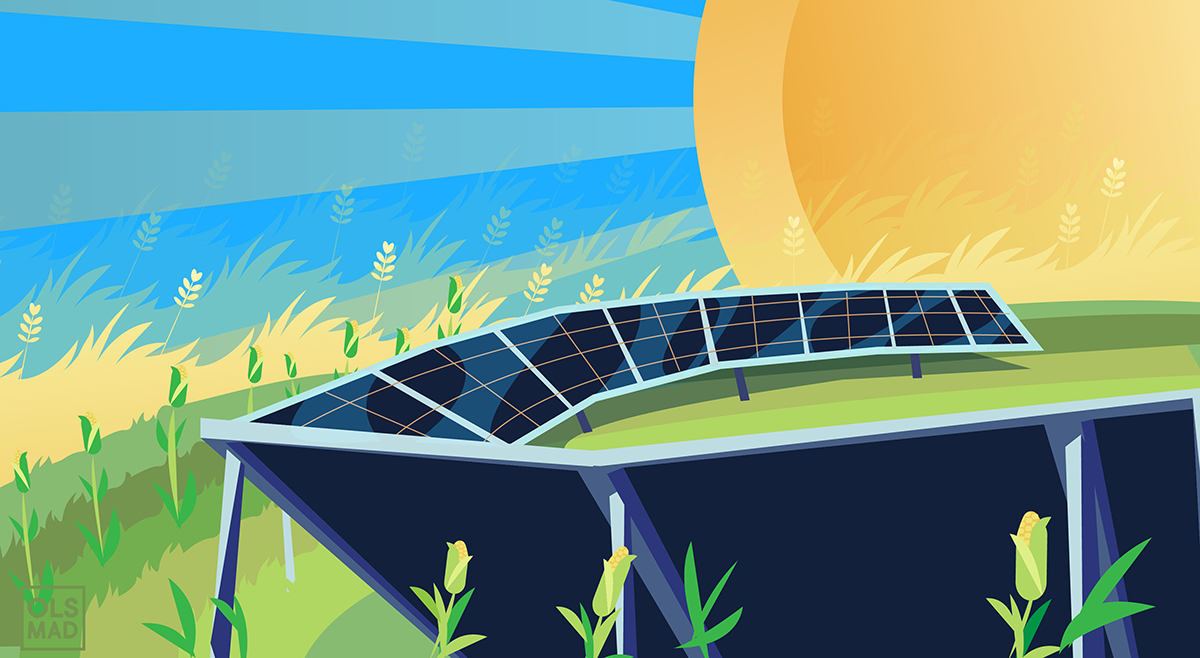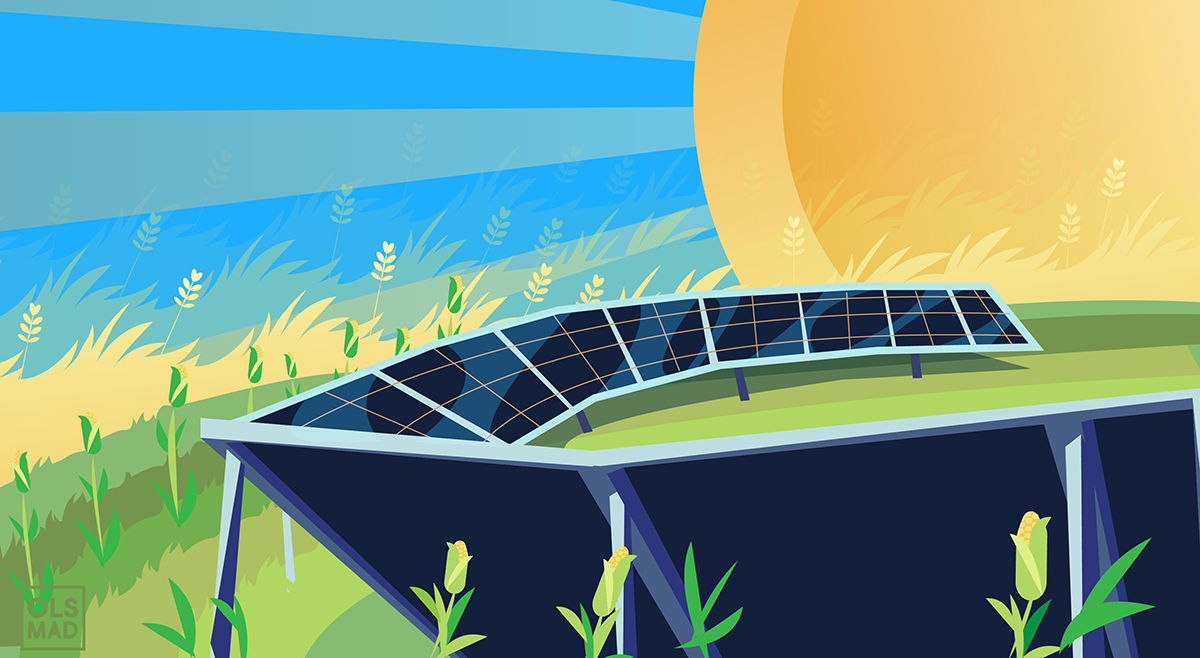
According to Chad Higgins, solar panels are like many plants: They do best in moderate temperatures, light wind, and relatively low humidity. So it stands to reason that solar energy and food crops might thrive in similar conditions.
A recent study by Higgins, an associate professor of ecological engineering at Oregon State University, and colleagues found just that. The team of OSU and University of Utah scientists monitored a solar array, modeled how air temperature, wind speed, and humidity affected its photovoltaic efficiency, and applied the model worldwide to determine the microclimates in which solar panels performed best. Their results, published last month in the journal Scientific Reports, found existing farmland is so conducive to solar energy that, were we to install solar panels on less than 1 percent of global agricultural land, they would produce enough electricity to offset global demand.
“Over thousands of years of agriculture, humans have found the best places to harvest the sun,” Higgins said. “What is agriculture but harvesting the sun for energy in the form of calories?”
Given the overwhelming challenge humanity faces in decarbonizing the electricity grid, the findings could be read as a call to action: slap solar panels on as much farmland as possible. But the real question is whether solar can be deployed on agricultural lands without contradicting crop production. Higgins and a growing number of researchers around the West, though, say choosing between ag and energy is a false dichotomy. So-called agrivoltaic projects that combine the two are popping up around the region, and they could turn any pending competition between energy and food into mutually beneficial cooperation.
Agrivoltaics incorporates both solar energy and agriculture by positioning solar panels a bit higher above the ground than in a typical array. The space underneath is reserved for crops, grasses, or pollinator habitat to grow in the partial shade of the panels. In some setups, arrays are built high enough for tractors to operate beneath them.
The system depends on an equal exchange between the panels above and the vegetation below. As Higgins’s recent study affirms, solar panels operate more efficiently when transpiration from underlying vegetation maintains a relatively cooler microclimate. On the flip side, researchers have shown that solar panels may also benefit vegetation, depending on the type of plant and conditions. The partial shade of the panels would mean, for example, a farmer might have to swap out sun-loving romaine for kale in an agrivoltaic plot.
After car and battery manufacturer Tesla installed experimental solar arrays on OSU-owned fields in 2013, Higgins noticed that the grass beneath the panels stayed a “deep, verdant green” while surrounding grass browned. The observation led him to the growing literature on agrivoltaics. He thought the system could make solar energy more efficient while shading crops to both retain water and keep plants — not to mention farmworkers — from overheating. It would be a win-win-win situation — particularly in a warming climate.
Greg Barron-Gafford, an associate professor of ecosystem science at the University of Arizona, had a similar serendipitous observation in 2015, when a student forgot to water sod that had been rolled out beneath a solar array at the Biosphere 2 research facility 30 miles north of Tucson. Barron-Gafford noticed that the grass around the edge of the panels died quickly in the Arizona sun. Beneath the panels, though, it stayed surprisingly green.
“We started to think about how to expand that,” said Barron-Gafford. “It was no longer a question of: Can plants survive? but rather: Could panels actually be good for plants?”
Barron-Gafford and his team built a 3-meter-tall racking system for solar panels and started farming. They started with the ingredients for salsa — jalapenos, tomatoes, and cilantro — before eventually growing melons, sweet potatoes, spinach, lettuce, kale, chard, and various herbs. The only crop that struggled under the panels was broccoli.
“A number of projects have been developed to show that agrivoltaics is possible. This works,” said Jordan Macknick, a natural resources and energy analyst at the National Renewable Energy Lab who is leading a countrywide study of agrivoltaics. “What we’re trying to do now is put robust science behind that to be able to better explain why we’re seeing these benefits.”
So far, Macknick’s research has shown that agrivoltaics doesn’t work everywhere — the system works best in places with hot, dry summers — nor does it need to be applied with a broad stroke. “I don’t think we’re going to see massive corn and soy operations converting to agrivoltaics,” he said. “We don’t need to cover all of Iowa with solar panels.”
Where agrivoltaics might be most relevant is on smaller-scale, high-value crop farms, which, according to Higgins, could be enough to approach his 1-percent deployment. One such solar-farm combo is taking shape in Colorado. Last year, Barron-Gafford and Macknick met Byron Kominek, who in 2016 took over his late grandfather’s 24-acre hay farm outside Boulder, Colorado. Kominek quickly shook up the operation by putting in an apple orchard, a vegetable garden, and some beehives. Then he set his sights on solar.
Throughout 2018, Kominek prodded Boulder County to allow solar installations on farmland, which, as Kominek said, “opens this option up to a number of other farms across Boulder County.” Construction on his 1.2 megawatt array is set to begin in 2020.
Kominek renamed his farm Jack’s Solar Garden, after his grandfather, and teamed up with utility Xcel Energy to set up a subscription service; Xcel ratepayers will get credits on their bill for buying into the solar array. Barron-Gafford and Macknick will conduct research on 3 acres of the farm, while the produce from the other 2 acres covered with panels will be sold through a community supported agriculture program.
For researchers like Macknick, Higgins, and Barron-Gafford, Jack’s Solar Garden could be another example of agrivoltaics as both an energy and a food solution. The technique is particularly applicable in the West, where climate change means conditions in Colorado and elsewhere may increasingly resemble those in Arizona.
“We know this works really well in the drylands,” said Barron-Gafford. “Let’s implement things now knowing that these changes are coming, to try to get ahead in figuring out sustainable ways of doing food and energy production.”

